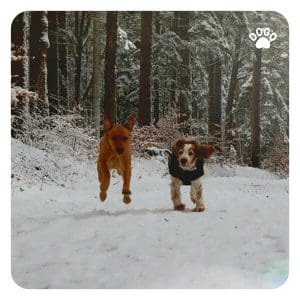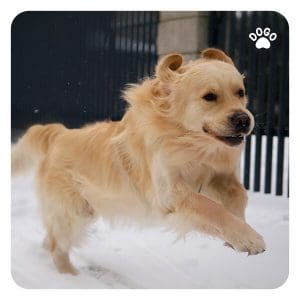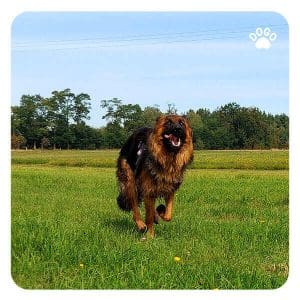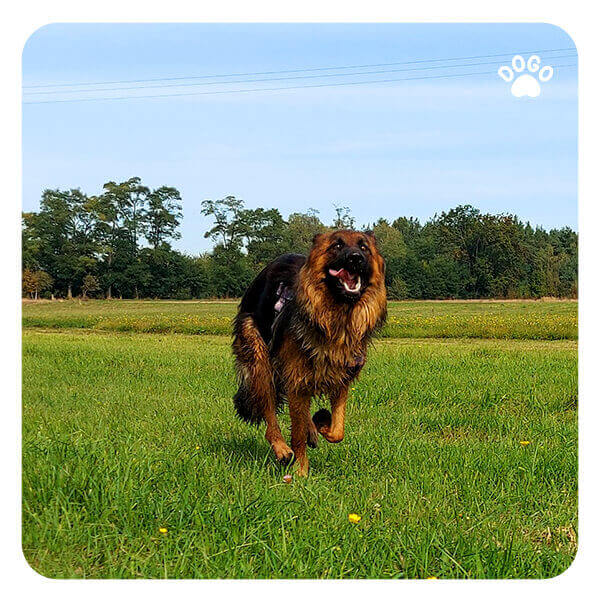 The command “Come” is one of the most important ones and every dog should learn it. It is not only extremely useful in everyday life but also plays an important role in our dog’s and others’ safety. The recall should be taught not to limit a dog with further commands, but to give them more freedom. If the command “Come” is mastered perfectly and you are sure that the dog will react when you call them, you don’t have to worry about their safety and even let them run freely without a leash in certain places.
The command “Come” is one of the most important ones and every dog should learn it. It is not only extremely useful in everyday life but also plays an important role in our dog’s and others’ safety. The recall should be taught not to limit a dog with further commands, but to give them more freedom. If the command “Come” is mastered perfectly and you are sure that the dog will react when you call them, you don’t have to worry about their safety and even let them run freely without a leash in certain places.
It’s important to note that mastering the “Come” command takes time and patience. Some dogs may learn faster than others, but it’s crucial not to rush the process. Dog owners should also keep in mind that training their furry friends requires consistency, repetition and positive reinforcement.
First steps
As with teaching any basic obedience command, the best time to start training recall is puppyhood. Young dogs often instinctively follow their handler, because they feel safe with them. It is worth taking advantage of it during training. As the dog gets older, however, they start to feel more comfortable being away from their pawrent. It is natural for them to get more curious and they become more open to exploring the surroundings.
We recommend initiating the recall training at home, as there are fewer distractions than outside. As a first step, try to run away from the dog and at the moment they start running towards you, give the command “Come”.
Initially, the command should be given when the dog is already running towards you, not before it happens. When the dog is already next to you, praise them with great enthusiasm and reward them with something awesome (a toy, a treat, petting, etc.). Coming back to you should be the best thing in the world for your furry baby. It is very important to find the form of reward that our dog enjoys the most.
When rewarding a dog, try to keep them around for as long as possible (of course, not forcefully!) so that they don’t learn to come only for a treat and then run away freely. In the first training sessions, the distance between you and the dog should not be far. As you practice more, try to walk further away.
You can also find a detailed description of recall training in our app. Read our tips and send your video for evaluation to Dogo trainers, who will help you eliminate potential mistakes.
Bigger distractions
 If your dog follows the command at home without any hesitation, you can practice in a different area (garden, meadow, fields, etc.). At first, it would be preferable to choose a rather quiet space, where there are not too many distractions such as people or other pets. Please be prepared that training in a different environment may not be as successful as at home. It is difficult for a dog to focus on their parent when there are many interesting smells, objects, and people around. For instance, you can train in a busier park or near a playground. It’s important to remember that training should always be done in a safe and controlled manner, and your dog should always be on a leash until you are confident that they will come back to you when called. Therefore, do not expfrform it perfectly right away. It’s crucial to avoid scolding your dog if they don’t respond to the command in a new environment. Instead, try to make the training experience more enjoyable for them by incorporating games and positive reinforcement.
If your dog follows the command at home without any hesitation, you can practice in a different area (garden, meadow, fields, etc.). At first, it would be preferable to choose a rather quiet space, where there are not too many distractions such as people or other pets. Please be prepared that training in a different environment may not be as successful as at home. It is difficult for a dog to focus on their parent when there are many interesting smells, objects, and people around. For instance, you can train in a busier park or near a playground. It’s important to remember that training should always be done in a safe and controlled manner, and your dog should always be on a leash until you are confident that they will come back to you when called. Therefore, do not expfrform it perfectly right away. It’s crucial to avoid scolding your dog if they don’t respond to the command in a new environment. Instead, try to make the training experience more enjoyable for them by incorporating games and positive reinforcement.
Begin the training with your pup on a long leash so that the dog has a sense of freedom and you feel secure that they cannot run away from you. Only when you observe that the dog understands the command well when there are many distractions, you can try to train without a leash.
At first, when the dog is busy sniffing or focused on something else, don’t call them back to you. In similar situations, it is very likely that your doggo will not respond to the command. The more you repeat the verbal cue and your pet doesn’t respond, the more the dog reinforces the belief that nothing will happen if they don’t come.
If your pet doesn’t respond to your call, get them interested in you, try to move around by clapping, leaning towards them, etc. For some dogs it will be much easier to run back to you when you are squatting or turned to their side than when you are standing tense and staring straight at them.
Essential rules
- Never call your dog to do activities that are unpleasant for them, such as bathing, clipping the leash on, etc. If you want your pet to come to you in those situations, play with them for a while, and only a few minutes later proceed with the “unpleasant” activities. The dog has to create a positive association with approaching you and be super happy about it.
- Never call your dog to reprimand them. If you do that, the next time they will not want to come to you with pleasure. When your pup comes back to you and you are angry at them (e.g. because they took a long time to come back), try not to express it as it can make your dog associate the recall command negatively and this is the opposite of what you are trying to accomplish.
- Don’t chase your dog. Your pup should follow you. Chasing your dog will probably cause them to run away from you even further, as they may take it as a game. If you are not sure your furry friend will react to your call in an unfamiliar place, it’s better to keep them on a long leash.
Rewards
 Like with teaching any other command, we recommend using a varied reward system. Sometimes, reward your dog with a treat, sometimes with a toy, and another time with enthusiastic praise. Training cannot be boring so always surprise your pup with something exciting and interesting.
Like with teaching any other command, we recommend using a varied reward system. Sometimes, reward your dog with a treat, sometimes with a toy, and another time with enthusiastic praise. Training cannot be boring so always surprise your pup with something exciting and interesting.
Additionally, rewards should have different values. For example, if the exercise is going well at home, reward your dog with praise. When the dog is performing well with distractions, for example when your dog sees another pup but they react to your call and immediately come back, offer them something extra, something that they like a lot.
Be prepared, though, that it takes a lot of patience and time to master recall 100%. Therefore practise, practise and practise. The more your train, the better your pup will become over time. Good luck!
For more advice read another article: Dog Running Away from Me. How to Prevent It.
[/fusion_text]



